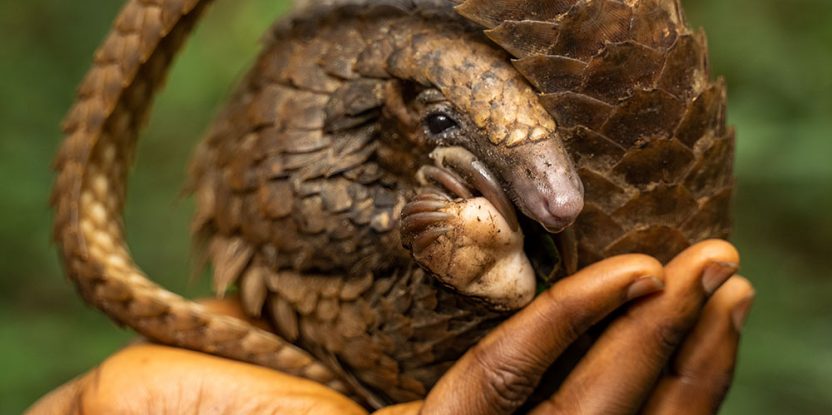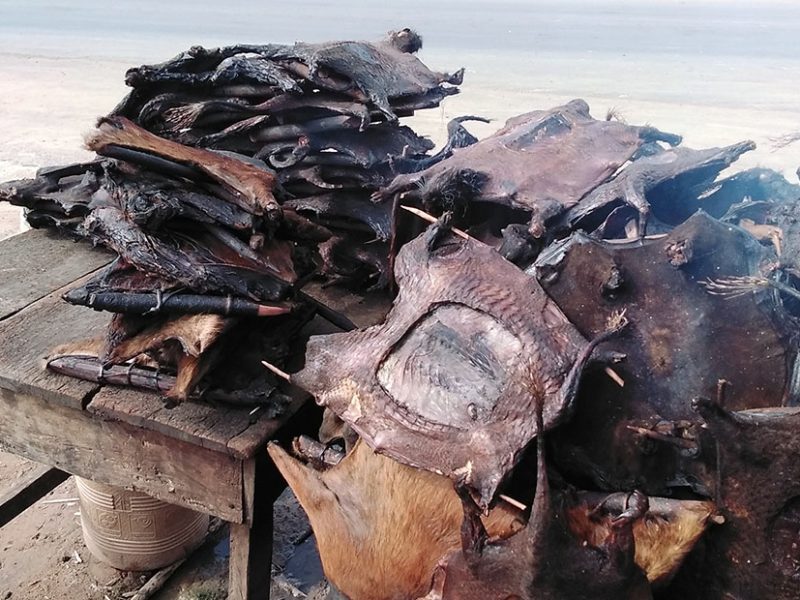
Hunting wild animals for food provides a critical source of food and income for many rural communities. Given that wild meat hunting in most areas is a relatively inexpensive and open-access resource, it is also thought to provide a ‘safety net’ in times of hardship, such as during socio-economic shocks caused by wars, natural disasters and pandemics that impact negatively on other livelihood opportunities and market access.
However, the unpredictability of shocks makes it difficult to quantitatively access this hypothesis in real-time. But a team of researchers that began studying hunting dynamics around south-east Nigeria’s Cross River National Park (CRNP) just before the COVID-19 pandemic found themselves extremely well-placed to study changes in wild meat hunting and use during the socio-economic shock that the pandemic – and the attendant policy response – invoked.
CRNP is one of the largest remaining forest blocks in the Guinean Forest biodiversity hotspot, home to vulnerable species such as chimpanzees (Pan troglodytes) and Cross River gorillas (Gorilla gorilla diehli), and the heavily trafficked white-bellied pangolin (Phataginus tricuspis).
Over a three-year period, during and after Nigeria’s COVID-19 lockdown, the team tracked 28 hunters in two rural communities and compared the frequency of successful hunting trips – trips in which at least one animal was captured – and their outcomes (number, mass, value, and use of animals caught).
“Very few quantitative assessments exist on how local communities use wildlife during socioeconomic shocks, like the one posed by COVID-19–induced lockdowns, because of the unpredictability of shocks,” said Charles A. Emogor, the study’s lead author and a PhD candidate at the University of Cambridge.
“We were lucky that our long-term study coincided with Nigeria’s lockdown, which allowed us to study how hunting and the use of wild meat might have changed in lockdown compared to non-lockdown periods,” he said. “To the best of our knowledge, this is the first quantitative interspecific study assessing changes in wild meat hunting and use during the pandemic.”
Navigating data collection during COVID was challenging, but the researchers mitigated this by working with local research assistants, as there were no movement restrictions within the communities. “We were surprised by the sustained interest of the hunters,” said Emogor; “we tracked most of them continuously for three years.”

Wild meat for sale on the side of the road. Photo by Charles Emogor/University of Cambridge
The results showed that the pandemic-related restrictions and their impacts prompted people to hunt more during the lockdown – and to eat more of what they caught rather than sell it. “Our work indicates that local communities used wild meat to buffer the impact of the shock caused by the lockdown,” said Lauren Coad, a senior scientist at the Centre for International Forestry Research and World Agroforestry (CIFOR-ICRAF), who is one of Emogor’s supervisors and a co-author on the study.
Successful hunting trips were more frequent during that time, with a corresponding increase in the monthly number, mass, and value of animals caught. Hunters consumed a larger proportion of wild meat in their homes than in non-lockdown periods, likely exacerbated by urban-rural migration increasing the number of mouths to feed within households. They also sold less meat as the markets were closed so trade was only happening within communities. The findings indicate that wild species “may be especially vulnerable to increased hunting pressure during such shocks,” said Coad.
They advocated that in future crises, policy interventions that disrupt normal socio-economic activities should take into account the likely impacts on food insecurity of rural communities, particularly those without access to hunting areas. Restrictive interventions such as blanket bans on hunting and consuming wild meat, they note, could be counterproductive, whilst measures like providing extra protein for communities during such periods might be helpful.
Overall, “the resilience of local communities and of wildlife populations are interlinked,” the co-authors concluded. “In the medium term, both rely on reducing hunting pressure during normal conditions (e.g., by promoting sustainable hunting practices and investing in site-based law enforcement in protected areas), to ensure that wildlife populations are not over-harvested and depleted. However, in many parts of Central Africa, wildlife resources have already been highly depleted, leaving no buffer for increased reliance on wildlife in times of hardship. Thus, without progress in reducing hunting pressures during less disrupted times, it is probable that future shocks will result in even greater economic and ecological impacts.”
We want you to share Forests News content, which is licensed under Creative Commons Attribution-NonCommercial-ShareAlike 4.0 International (CC BY-NC-SA 4.0). This means you are free to redistribute our material for non-commercial purposes. All we ask is that you give Forests News appropriate credit and link to the original Forests News content, indicate if changes were made, and distribute your contributions under the same Creative Commons license. You must notify Forests News if you repost, reprint or reuse our materials by contacting forestsnews@cifor-icraf.org.